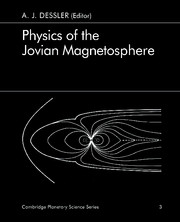Book contents
- Frontmatter
- Contents
- List of tables
- List of contributors
- Foreword
- Preface
- 1 Jupiter's magnetic field and magnetosphere
- 2 Ionosphere
- 3 The low-energy plasma in the Jovian magnetosphere
- 4 Low-energy particle population
- 5 High-energy particles
- 6 Spectrophotometric studies of the Io torus
- 7 Phenomenology of magnetospheric radio emissions
- 8 Plasma waves in the Jovian magnetosphere
- 9 Theories of radio emissions and plasma waves
- 10 Magnetospheric models
- 11 Plasma distribution and flow
- 12 Microscopic plasma processes in the Jovian magnetosphere
- Appendix A Symbols and acronyms
- Appendix B Coordinate systems
- Appendix C Jupiter and Io: selected physical parameters
- References
- Index
9 - Theories of radio emissions and plasma waves
Published online by Cambridge University Press: 27 October 2009
- Frontmatter
- Contents
- List of tables
- List of contributors
- Foreword
- Preface
- 1 Jupiter's magnetic field and magnetosphere
- 2 Ionosphere
- 3 The low-energy plasma in the Jovian magnetosphere
- 4 Low-energy particle population
- 5 High-energy particles
- 6 Spectrophotometric studies of the Io torus
- 7 Phenomenology of magnetospheric radio emissions
- 8 Plasma waves in the Jovian magnetosphere
- 9 Theories of radio emissions and plasma waves
- 10 Magnetospheric models
- 11 Plasma distribution and flow
- 12 Microscopic plasma processes in the Jovian magnetosphere
- Appendix A Symbols and acronyms
- Appendix B Coordinate systems
- Appendix C Jupiter and Io: selected physical parameters
- References
- Index
Summary
A generally accepted theory of the enigmatic phenomenon of planetary radio emission is not yet available. In this chapter, we direct our attention primarily to the question of how the Jovian decameter radiation might be generated via both direct and indirect mechanisms. Direct mechanisms transform the free energy contained in an electron distribution (typically a loss-cone) directly into electromagnetic waves. Indirect mechanisms transform the free energy contained in an electron beam distribution first into electrostatic waves that can then couple, in some manner, to produce electromagnetic waves. The growth rates for the unstable electromagnetic and electrostatic waves are derived. Nonlinear theories are briefly discussed as they apply to the case of Jupiter's decametric radiation. Because most of the Jovian radio emission seems to be controlled by Io, we describe how Io, through the emission of kinetic Alfven waves, can produce a “beamlike” electron distribution. It is more difficult to understand how Io can enhance or produce a “loss-cone” distribution. Thus we conclude that, at least for Jovian radio phenomena, indirect mechanisms are preferred. We also describe theories and models for the generation of the dynamic spectral arcs that characterize the radio spectrum from hectometric to decametric wavelengths.
Introduction
Jupiter is the most powerful planetary source of nonthermal electromagnetic radiation in the solar system, with a radio spectrum extending from a few kHz to over 100 MHz. The phenomenology of the decimeter component in the GHz range has been discussed in Chapter 7.
- Type
- Chapter
- Information
- Physics of the Jovian Magnetosphere , pp. 317 - 352Publisher: Cambridge University PressPrint publication year: 1983
- 69
- Cited by



